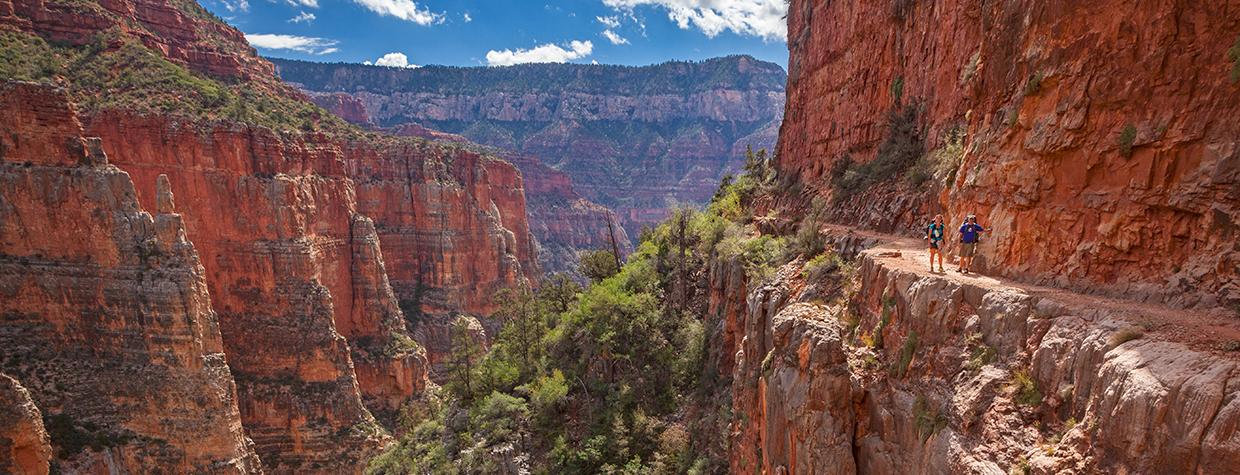There’s no shortage of great hikes on the North Rim: Widforss, Uncle Jim, Ken Patrick. Most, however, at least in the vicinity of Grand Canyon Lodge, stay up top and stick to the woods. You’ll get some great views of the Canyon along the way, but those trails won’t take you down. The North Kaibab Trail is the exception. If you really want to experience one of the Seven Natural Wonders and see what it’s like to look up for a change, this is your best option. But before you get started, you need to understand something: Even though this trail winds for 14 miles to Phantom Ranch, the farthest you should ever go on a day hike is to Roaring Springs. It’s a 10-mile round-tripper, and like all hikes into the Canyon, the trek down is pretty easy, but coming out ... well, the North Kaibab will take your breath away. Literally. Figuatively.
The trailhead is a couple of miles north of the lodge — it shares a parking lot with Uncle Jim and Ken Patrick. Unlike its sister to the south, the North Kaibab begins with big trees, including Douglas-firs, Engelmann spruce and ponderosa pines. You’ll be tempted to look up, but keep your eyes on the trail. Specifically, watch out for the mules and their leftovers. Mule trains have the right of way in the Canyon, and when you encounter one, step to the inside of the trail and await instructions from the wrangler. Generally, all you have to do is wait for them to pass. When they do, you can move on.
After about 15 minutes of switchbacking — longer if you’re strolling or interrupted by multiple mule trains — you’ll come to the Coconino Overlook. If you haven’t taken the time to gaze out at the wonder before you, now is a good time. What you’re seeing is Roaring Springs Canyon, one of the many side canyons in the Grand Canyon. This one, however, is probably the most important, because water from the springs helps supply the national park’s lodges and other facilities. By the way, when you’re hiking back up, but still a few hundred yards below this overlook, you’ll hear the voices of people standing at the overlook. There’s an echo phenomenon that’ll make you think there are people right behind you on the trail, but they’re actually up above.
Heading downhill, you’ll come to a restroom and a water fountain, followed by a 20-foot tunnel. After the tunnel, the switchbacks continue, but the trees are left behind. The makeup of the trail itself changes, too. Above the tunnel, the ground is sandy. Below the tunnel, it starts getting rocky. It’ll stay like that all the way to the bridge, which you’ll cross about an hour into the hike. After the bridge, there’s a rare uphill climb in the Canyon — rare on a downhill hike, that is. The rise takes you to the southwest wall of the canyon, where the trail follows a long ledge with steep drop-offs to your left. It’s along this stretch that you’ll first hear the springs. About 15 minutes later, you’ll catch your first glimpse of the water.
Eventually, about two hours from the trailhead, you’ll come to the mouth of the canyon and an intersection. To the right is the route to Cottonwood Campground and Phantom Ranch. To the left is Roaring Springs, which is 10 minutes away. At this point, you’ll have dropped almost 3,000 feet in elevation. There are some picnic tables and a restroom at Roaring Springs. You should use the facilities, but you should also take off your backpack and enjoy the surroundings. And maybe think about what it was like to live there. Something world-renowned artist Bruce Aiken and his family did for 33 years.
It was Bruce’s job to serve as caretaker of the pump house at Roaring Springs. “I heard about this job,” Bruce says. “I was summer help, working on a trail crew living over at Cottonwood Camp. We were working on the North Kaibab Trail, so we used to come right past this house on our way to work. I used to look at it and think how great it would be to live here. And then, of course, I got the job.”
It was a rare opportunity — to live in such a remarkable place — and when people would ask him if he missed “the real world,” he’d correct them: “This is the real world.” It’s also the payoff on one of the premier trails in Arizona. When you’re in Maui, you expect waterfalls like this, but not in the Grand Canyon. It’s spectacular. Drink it in and remember: You still have 5 miles and 3,000 feet between you and the trailhead.
trail guide
Length: 10 miles round-trip (to Roaring Springs)
Difficulty: Strenuous
Elevation: 8,225 to 5,221 feet
Trailhead GPS: N 36˚13.020', W 112˚03.395'
Directions: From Grand Canyon Lodge on the North Rim, go north on State Route 67 (North Rim Parkway) for 2 miles to the signed right turn for the North Kaibab Trailhead.
Special Consideration: National Park Service fees apply.
Vehicle Requirements: None
Dogs Allowed: No
Horses Allowed: No
USGS Maps: Bright Angel Point, Phantom Ranch
Information: Backcountry Office, Grand Canyon National Park, 928-638-7875 or nps.gov/grca

